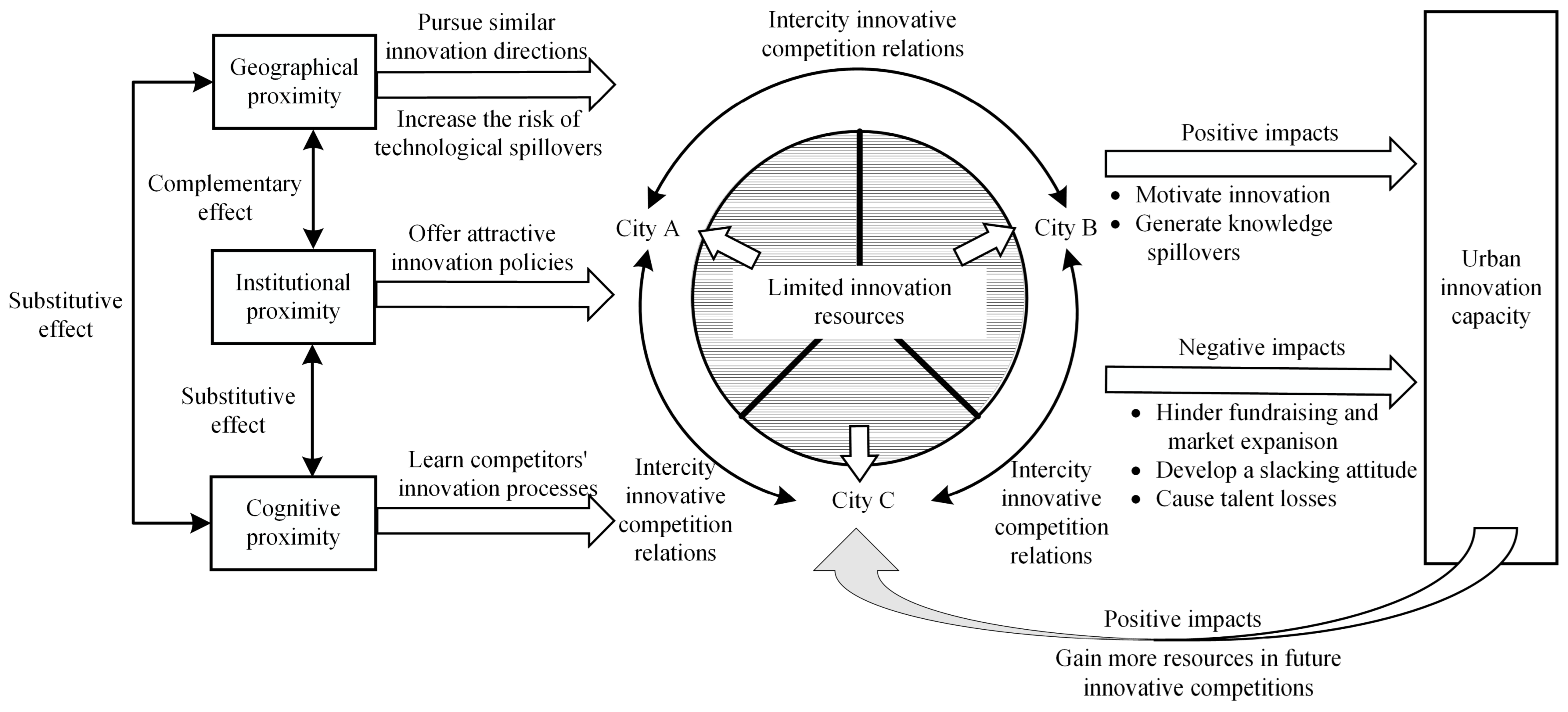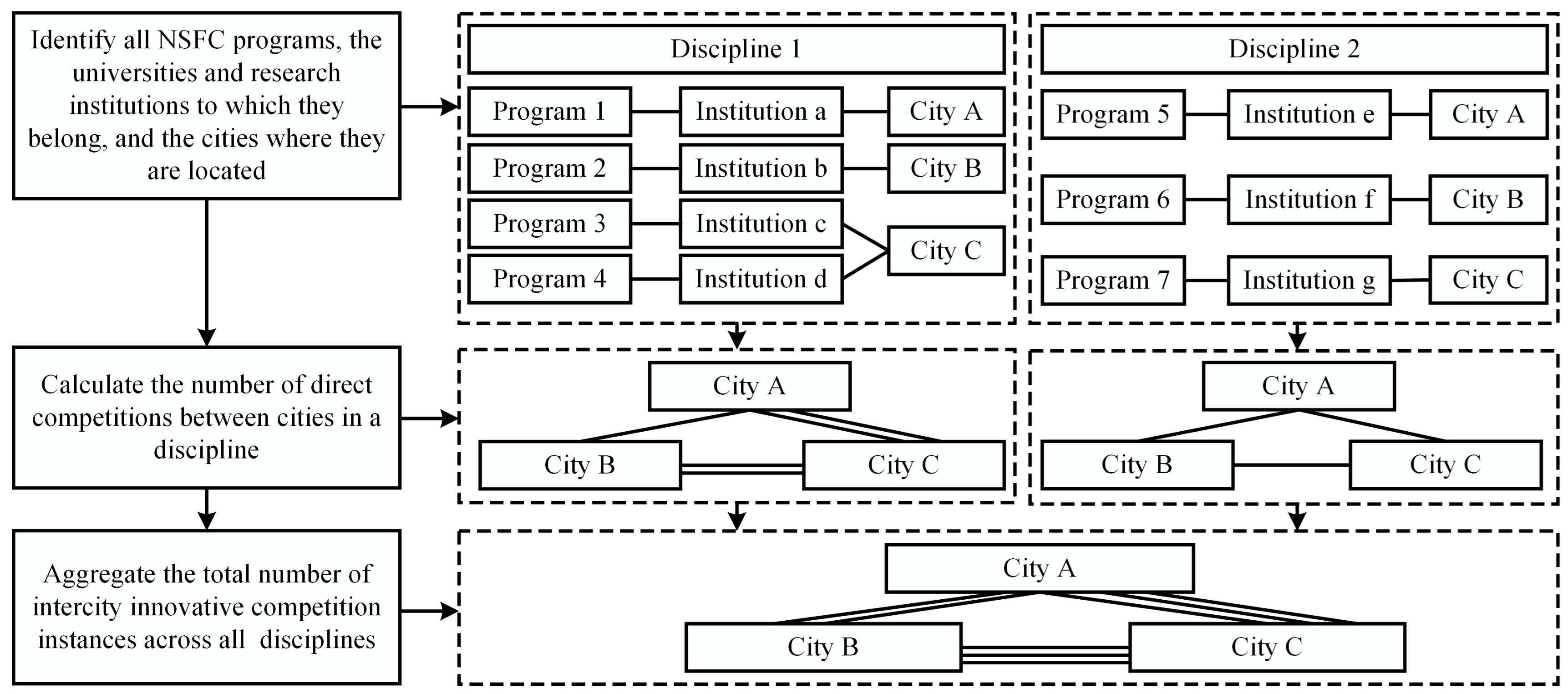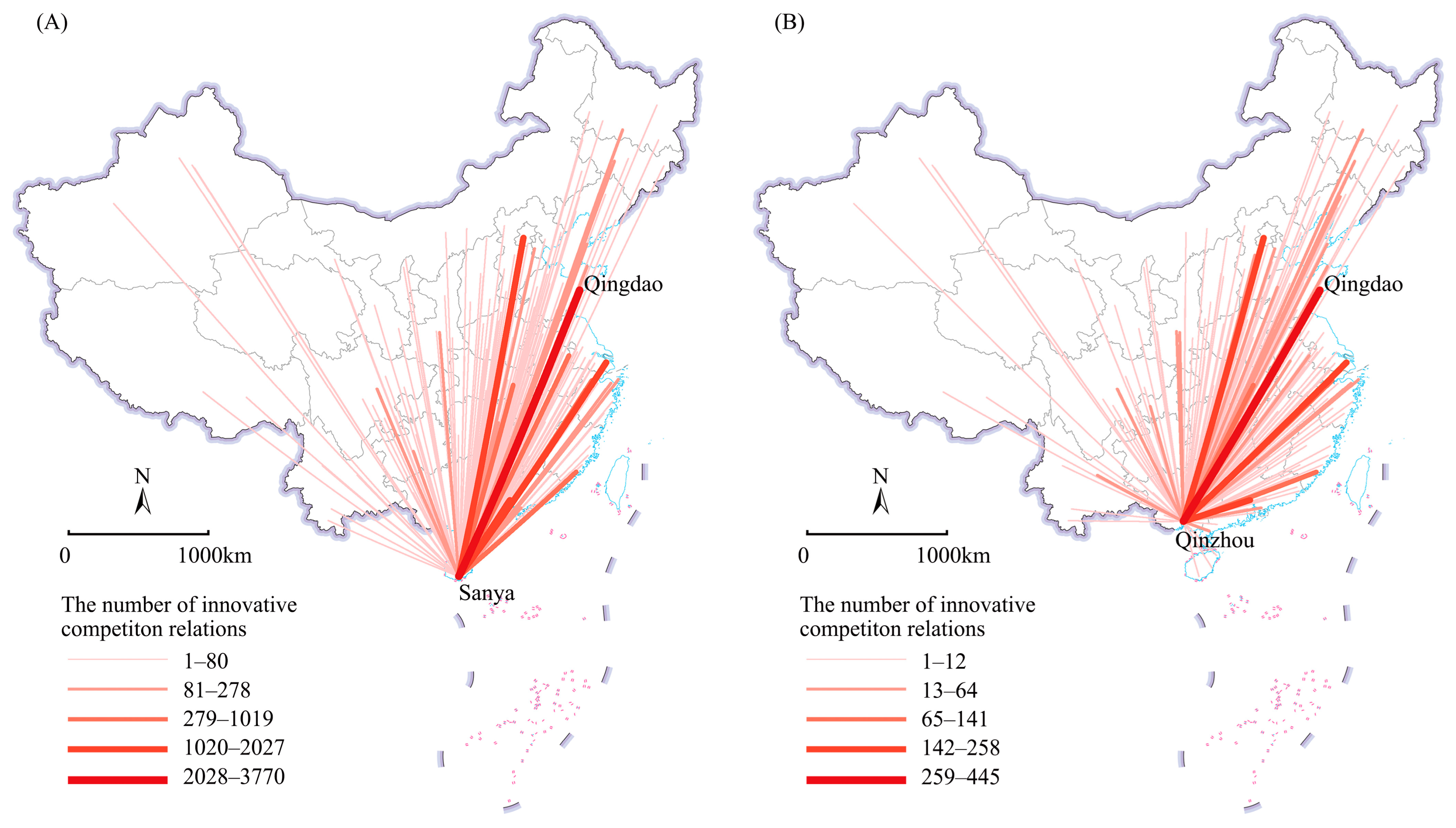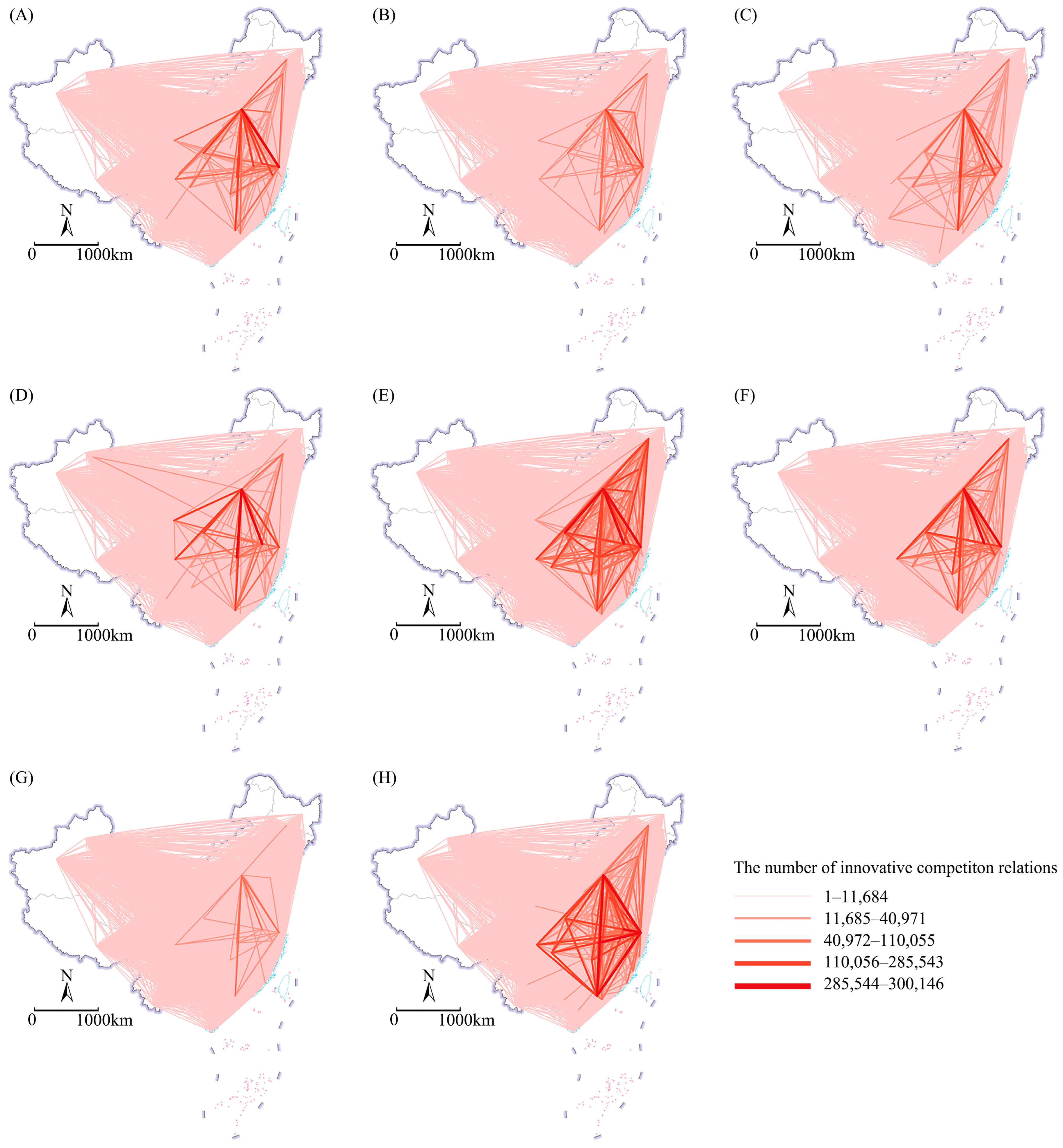Spatial Characteristics and Influencing Factors of Intercity Innovative Competition Relations in China
Abstract
1. Introduction
2. Theoretical Framework
3. Materials and Methods
3.1. Data Sources
3.2. Research Methods
3.2.1. Social Network Analysis
3.2.2. Negative Binomial Regression Model
4. Results
4.1. Characteristics of Intercity Innovative Competition Relations in China
4.1.1. Gradually Rising Intensity of Intercity Innovative Competition Relations in China
4.1.2. Clustering of Intercity Innovative Competition Relations in China towards Cities with Higher Administrative Ranks
4.1.3. Beijing at the Centre of Innovative Competition Relations, yet with a Slight Decline in Its Position
4.1.4. Cities as Benchmarks in Innovative Competitions by Fully Leveraging Disciplinary Strengths in Competitions
4.1.5. Higher Average Number of Innovative Competitions between Cities That Are Geographically Close to Each Other
4.1.6. Significant Differences in the Intensity of Intercity Innovative Competitions in China among Various Academic Disciplines
4.2. Influencing Factors of Intercity Innovative Competition Relations in China
4.2.1. Impact of Urban Innovation Capacity on the Intercity Innovative Competition Relations
4.2.2. Impact of Multidimensional Proximity on the Intercity Innovative Competition Relations
4.2.3. Interactive Influences of Multidimensional Proximity
5. Conclusions and Discussion
Author Contributions
Funding
Data Availability Statement
Conflicts of Interest
References
- Yu, T.; Gu, C. On urban competition and competitiveness. Urban Plan. Forum 2004, 6, 16–21. [Google Scholar]
- Chen, S.; Lin, J.; Yang, L.; Zhang, H. Study on urban competition strategy based on the theory of niche. Hum. Geogr. 2006, 2, 72–76. [Google Scholar]
- He, Z.; Luo, X.; Gu, Z. The regional strategy and the new trends of competition and cooperation in the Yangtze River Delta. Econ. Geogr. 2022, 42, 45–51. [Google Scholar]
- Liu, J.; Dong, W. The effect of major cities competition and cooperation on construction of Shanghai global cities: A comparative analysis based on urban strategy. Urban Dev. Stud. 2016, 23, 74–81. [Google Scholar]
- Lai, K. Differentiated markets: Shanghai, Beijing and Hong Kong in China’s financial centre network. Urban Stud. 2012, 49, 1275–1296. [Google Scholar] [CrossRef]
- Zhang, W.; Qian, Y. Unpacking intercity competitive relations in the global corporate spatial organization of manufacturing. Glob. Netw. 2024, e12469. [Google Scholar] [CrossRef]
- Lyu, L.; Liao, Q.; Huang, R. Knowledge specialization of cities above the prefecture level in China based on journal articles. Sci. Geogr. Sin. 2018, 38, 1245–1255. [Google Scholar]
- Kamien, M.I.; Schwartz, N.L. Timing of innovations under rivalry. Econometrica 1972, 40, 43–60. [Google Scholar] [CrossRef]
- Kamien, M.I.; Schwartz, N.L. Market structure and innovation-survey. J. Econ. Lit. 1975, 13, 1–37. [Google Scholar]
- Porter, M.E. The competitive advantage of nations. Harvard. Bus. Rev. 1990, 68, 73–93. [Google Scholar]
- Zhang, G.; Xiong, L. How does the competitive relationship affect universities’ scientific research performance: Perspective from the competition networks in chemical field. Chin. Soft Sci. 2020, 10, 12–25. [Google Scholar]
- Hoffmann, W.; Lavie, D.; Reuer, J.J.; Shipilov, A. The interplay of competition and cooperation. Strateg. Manag. J. 2018, 39, 3033–3052. [Google Scholar] [CrossRef]
- Yang, Z.; Li, Y.; Liu, F.; Wei, W. Research on the influence of competitive relations on participators’ innovation performance in crowdsourcing contests: The moderating role of competition intensity. Mod. Manag. 2022, 42, 97–104. [Google Scholar]
- Yang, B.; Wang, T.; Li, Z.; Jiang, P. A study on the trend of domestic mobility and evolution of Chinese researchers. Stud. Sci. Sci. 2024, 1–16. [Google Scholar] [CrossRef]
- Xu, G.; Wang, L.; Zhou, Y. Comparative analysis of objective entrepreneurial cost and subjective entrepreneurial cost perception in key cities in China. Stud. Sci. Sci. 2021, 39, 463–470. [Google Scholar]
- Zhou, Z.; Dou, L. Prediction of potential competition and cooperation between enterprises from the perspective of patent: Taking perovskite solar cells as an example. Sci. Technol. Manag. Res. 2023, 43, 136–145. [Google Scholar]
- Li, B.; Ding, K.; Sun, X. Predicting potential technology partners and competitors of enterprises: A case study on fuel cell technology. J. Chin. Soc. Sci. Tech. Inf. 2021, 40, 1043–1051. [Google Scholar]
- Wei, Y.; Teng, G.; Guo, S.; Tuo, R. Multidimensional analysis on technological competition based on competing patent network: Taking 3D printing technology as an example. J. Inf. Res. Manag. 2020, 10, 99–108. [Google Scholar]
- Luo, J.; Liao, T.; Shi, M.; Cai, L.; Li, W. The identification of potential competitors from the perspective of emerging technologies. Inf. Sci. 2021, 39, 98–104. [Google Scholar]
- Dai, L.; Cao, Z.; Ma, H.; Ji, Y. The influencing mechanisms of evolving structures of China’s intercity knowledge collaboration networks. Acta Geogr. Sin. 2023, 78, 334–350. [Google Scholar]
- Florida, R.; Adler, P.; Mellander, C. The city as innovation machine. Reg. Stud. 2017, 51, 86–96. [Google Scholar] [CrossRef]
- Boschma, R.A. Proximity and innovation: A critical assessment. Reg. Stud. 2005, 39, 61–74. [Google Scholar] [CrossRef]
- Knoben, J.; Oerlemans, L.A.G. Proximity and inter-organizational collaboration: A literature review. Int. J. Manag. Rev. 2006, 8, 71–89. [Google Scholar] [CrossRef]
- Zhou, R.; Qiu, Y.; Hu, Y. Characteristics, evolution and mechanism of inter-city innovation network in China: From a perspective of multi-dimensional proximity. Econ. Geogr. 2021, 41, 1–10. [Google Scholar]
- Nooteboom, B.; Van, H.W.; Duysters, G.; Gilsing, V.; Oord, A.v.d. Optimal cognitive distance and absorptive capacity. Res. Policy 2007, 36, 1016–1034. [Google Scholar] [CrossRef]
- Qi, H.; Zhao, M.; Liu, S.; Gao, P.; Liu, Z. Evolution pattern and its driving forces of China’s interprovincial migration of highly-educated talents from 2000 to 2015. Geogr. Res. 2022, 41, 456–479. [Google Scholar]
- Zhan, Y.; Gu, R. Characteristics and multi-dimensional proximity mechanism of the online game industry cooperative network in China. Prog. Geogr. 2022, 41, 1145–1155. [Google Scholar] [CrossRef]
- Dai, L.; Liu, C.; Wang, S.; Ji, Y.; Ding, Z. Proximity and self-organizing mechanisms underlying scientific collaboration of cities in the Yangtze River Delta. Geogr. Res. 2022, 41, 2499–2515. [Google Scholar]
- He, C.; Jin, L.; Liu, Y. How does multi-proximity affect the evolution of export product space in China? Geogr. Res. 2017, 36, 1613–1626. [Google Scholar]
- Cao, Z.; Derudder, B.; Peng, Z. Interaction between different forms of proximity in inter-organizational scientific collaboration: The case of medical sciences research network in the Yangtze River Delta region. Pap. Reg. Sci. 2019, 98, 1903–1924. [Google Scholar] [CrossRef]
- He, S.; Du, D.; Jiao, M.; Lin, Y. Spatial-temporal characteristics of urban innovation capability and impact factors analysis in China. Sci. Geogr. Sin. 2017, 37, 1014–1022. [Google Scholar]
- Wang, J.; Yan, Y.; Hu, S. Spatial pattern and determinants of Chinese urban innovative capabilities base on spatial panel data model. Sci. Geogr. Sin. 2017, 37, 11–18. [Google Scholar]
- Jiang, Y.; Yang, N.; Liu, X.; Yuan, Y.; Li, L.; Lu, Y.; Jin, B. Study on the lay out of NSFC in China. Sci. Sci. Manag. S. T. 2003, 3, 5–10. [Google Scholar]
- Gui, Q.; Du, D.; Liu, C.; Xu, W.; Hou, C.; Jiao, M.; Zhai, C.; Lu, H. Structural characteristics and influencing factors of the global inter-city knowledge flows network. Geogr. Res. 2021, 40, 1320–1337. [Google Scholar]
- Ryu, W.; McCann, B.T.; Reuer, J.J. Geographic co-location of partners and rivals: Implications for the design of R&D alliances. Acad. Manag. J. 2018, 61, 945–965. [Google Scholar]
- Hao, H.; Zhao, Y.; Yang, H.; Gao, F.; An, H.; Hao, J.; Zhang, S.; Li, Z.; Zheng, Z.; Yang, L.; et al. Proposal application, peer review and funding of National Natural Science Foundation of China in 2022: An overview. Bull. Nat. Nat. Sci. Found. Chin. 2023, 37, 3–6. [Google Scholar]
- Liu, H.; Wang, L.; Li, Y. An exploration of the research frontiers of co-opetition theory. For. Econ. Manag. 2009, 31, 1–8. [Google Scholar]





| Indicators | Meaning of Indicators | Calculation Formula | Explanation of Indicators |
|---|---|---|---|
| Network Density | Network density is the ratio of a network’s actual connections to the maximum feasible number of connections. It characterizes the closeness of intercity innovative competition relations. | D is the network density; L is the actual number of connections in a network; and n is the number of city nodes. The threshold for network density is [0, 1]. | |
| Degree Centrality | If a city has a high degree centrality, it occupies a central position in the city network, possessing more power, status, and the ability to aggregate resources. | is the degree centrality of city i; and is the number of innovative competition relations between city i and city j. |
| Multidimensional Proximity Variables | Measurement Methods |
|---|---|
| This paper calculates the Euclidean distance between the centres of two innovative competition cities through the geosphere package in R language and implements standardisation referring to existing research [24]. The calculation formula is as follows: indicates the maximum distance between cities in China. takes a value of 1 or above; a large value corresponds to a high degree of geographical proximity between cities. | |
| Referring to existing studies [27], this paper assesses institutional proximity by examining the administrative-level relationship between cities. If both cities have higher administrative ranks, then the value is 3; if only one of the two cities has a higher administrative rank and the other is an ordinary city, then the value is 1; if both cities are ordinary cities, then the value is 0. | |
| Referring to existing studies [28], this paper firstly collects the distribution series of general programs of the NSFC in each discipline and then illustrates cognitive proximity by calculating the closeness of the application directions of general programs of the NSFC between cities according to the cosine similarity rule. |
| Quantitative Characteristics and Social Network Indicators of Innovative Competition Relations | 2005–2009 | 2010–2014 | 2015–2019 |
|---|---|---|---|
| The number of innovative competitions | 5,269,947 | 44,374,262 | 60,657,509 |
| The number of cities in innovative competition relations | 150 | 192 | 197 |
| Network density | 0.15 | 0.28 | 0.28 |
| The number of innovative competitions involving cities with high administrative ranks | 5,231,039 | 43,940,744 | 60,020,918 |
| The percentage of innovative competitions involving cities with high administrative ranks | 99.26% | 99.02% | 98.95% |
| The number of innovative competitions involving both cities with high administrative ranks | 4,410,928 | 36,095,257 | 48,981,916 |
| The percentage of innovative competitions involving both cities with high administrative ranks | 83.70% | 81.34% | 80.75% |
| 2005–2009 | 2010–2014 | 2015–2019 | |||
|---|---|---|---|---|---|
| City | Centrality in Innovative Competitions | City | Centrality in Innovative Competitions | City | Centrality in Innovative Competitions |
| Beijing | 2,227,518 | Beijing | 15,179,363 | Beijing | 19,164,325 |
| Shanghai | 1,035,246 | Shanghai | 9,143,353 | Shanghai | 12,780,678 |
| Nanjing | 722,837 | Nanjing | 5,818,906 | Nanjing | 8,679,340 |
| Wuhan | 616,176 | Guangzhou | 5,220,426 | Guangzhou | 8,116,602 |
| Xi’an | 512,183 | Wuhan | 5,160,496 | Wuhan | 7,177,656 |
| Guangzhou | 506,820 | Xi’an | 4,554,071 | Xi’an | 6,061,432 |
| Hangzhou | 454,838 | Hangzhou | 3,859,669 | Hangzhou | 4,990,209 |
| Hefei | 371,155 | Changsha | 3,151,986 | Changsha | 3,961,060 |
| Chengdu | 332,780 | Chengdu | 2,750,964 | Chengdu | 3,947,738 |
| Tianjin | 324,528 | Tianjin | 2,697,680 | Tianjin | 3,835,319 |
| Top 1 Connected Cities | Top 3 Connected Cities | Top 10 Connected Cities | |
|---|---|---|---|
| 2005–2009 | Beijing (147) Shanghai (3) | Beijing (149) Shanghai (128) Nanjing (90) Guangzhou (19) Xi’an (15) Wuhan (13) Hangzhou (13) Hefei (6) Lanzhou (5) Tianjin (3) | Beijing (149) Shanghai (144) Wuhan (144) Nanjing (142) Guangzhou (141) Hangzhou (135) Xi’an (120) Tianjin (95) Chengdu (92) Hefei (84) |
| 2010–2014 | Beijing (185) Shanghai (5) Qingdao (2) | Beijing (189) Shanghai (158) Nanjing (111) Guangzhou (44) Wuhan (32) Xi’an (11) Changsha (7) Hangzhou (5) Qingdao (4) Shenyang (4) | Beijing (191) Shanghai (190) Nanjing (187) Wuhan (186) Guangzhou (181) Hangzhou (175) Xi’an (165) Changsha (123) Chengdu (100) Tianjin (100) |
| 2015–2019 | Beijing (180) Shanghai (14) Qingdao (2) Harbin (1) | Beijing (195) Shanghai (160) Nanjing (106) Guangzhou (50) Wuhan (28) Xi’an (26) Qingdao (5) Shenyang (5) Changsha (3) Harbin (3) | Beijing (196) Wuhan (194) Shanghai (193) Nanjing (189) Xi’an (181) Guangzhou (181) Hangzhou (174) Changsha (126) Tianjin (110) Chengdu (108) |
| 2005–2009 | 2010–2014 | 2015–2019 | ||||||
|---|---|---|---|---|---|---|---|---|
| City 1 | City 2 | Number of Innovative Competitions | City 1 | City 2 | Number of Innovative Competitions | City 1 | City 2 | Number of Innovative Competitions |
| Beijing | Shanghai | 292,265 | Beijing | Shanghai | 1,933,965 | Beijing | Shanghai | 2,436,375 |
| Beijing | Nanjing | 205,185 | Beijing | Nanjing | 1,315,461 | Beijing | Nanjing | 1,772,439 |
| Beijing | Wuhan | 171,311 | Beijing | Wuhan | 1,123,563 | Beijing | Guangzhou | 1,445,014 |
| Beijing | Xi’an | 135,766 | Beijing | Guangzhou | 1,026,202 | Beijing | Wuhan | 1,420,771 |
| Beijing | Guangzhou | 134,479 | Beijing | Xi’an | 934,910 | Guangzhou | Shanghai | 1,234,036 |
| Beijing | Hangzhou | 120,085 | Beijing | Hangzhou | 785,369 | Beijing | Xi’an | 1,170,687 |
| Beijing | Hefei | 110,029 | Guangzhou | Shanghai | 701,000 | Nanjing | Shanghai | 993,512 |
| Beijing | Chengdu | 88,539 | Beijing | Changsha | 637,418 | Beijing | Hangzhou | 919,603 |
| Beijing | Tianjin | 80,707 | Nanjing | Shanghai | 629,774 | Shanghai | Wuhan | 824,850 |
| Beijing | Changsha | 79,489 | Beijing | Chengdu | 582,473 | Beijing | Chengdu | 756,181 |
| Year | Intercity Distance | Average Number of Innovative Competitions | ||
|---|---|---|---|---|
| Both Cities Are Cities with Higher Administrative Ranks | One of the Two Cities Has a Higher Administrative Rank and the Other Is an Ordinary City | Both Cities Are Ordinary Cities | ||
| 2005–2009 | 0–500 km | 8.15 | 287.65 | 9971.92 |
| 500–1000 km | 7.55 | 260.23 | 9466.95 | |
| 1000–1500 km | 4.69 | 206.18 | 9029.64 | |
| 1500–2000 km | 4.26 | 123.65 | 5188.02 | |
| Above 2000 km | 0.88 | 50.73 | 1733.44 | |
| 2010–2014 | 0–500 km | 55.53 | 2185.20 | 77,585.81 |
| 500–1000 km | 47.07 | 1840.83 | 77,208.10 | |
| 1000–1500 km | 25.74 | 1407.36 | 71,399.71 | |
| 1500–2000 km | 24.83 | 839.83 | 42,194.09 | |
| Above 2000 km | 10.64 | 370.65 | 12,604.52 | |
| 2015–2019 | 0–500 km | 80.38 | 2982.91 | 104,912.78 |
| 500–1000 km | 63.41 | 2557.76 | 103,375.63 | |
| 1000–1500 km | 38.71 | 1947.41 | 96,144.78 | |
| 1500–2000 km | 32.27 | 1140.12 | 60,160.59 | |
| Above 2000 km | 10.83 | 434.07 | 17,122.34 | |
| 2005–2009 | 2010–2014 | 2015–2019 | |||||
|---|---|---|---|---|---|---|---|
| Model 1 | Model 2 | Model 3 | Model 4 | Model 5 | Model 6 | ||
| Proximity | GEOij | 0.199 *** | 0.184 *** | 0.120 *** | |||
| INSij | 2.028 *** | 2.001 *** | 2.102 *** | ||||
| COGij | 11.272 *** | 12.108 *** | 11.799 *** | ||||
| Interaction terms | GEOij × INSij | 0.360 *** | 0.357 *** | 0.212 *** | |||
| GEOij × COGij | −1.616 *** | −1.462 *** | −1.200 *** | ||||
| INSij × COGij | −5.031 *** | −5.312 *** | −5.791 *** | ||||
| Urban innovation capacity | UIC | 15.808 *** | 2.772 *** | 2.125 *** | 0.369 *** | 1.605 *** | 0.473 *** |
| Control variables | CAP | 0.209 *** | 0.051 *** | 0.173 *** | 0.041 *** | 0.078 *** | 0.011 *** |
| RDI | 0.816 *** | 0.128 *** | 5.262 *** | 1.264 *** | 49.260 *** | 26.065 *** | |
| Constant term | 2.887 *** | −0.928 *** | 4.393 *** | 0.658 *** | 4.389 *** | 0.810 *** | |
| Alpha | 6.101 | 2.458 | 5.862 | 3.053 | 6.275 | 3.348 | |
| Log likelihood | −39,368.252 | −35,068.247 | −81,141.277 | −75,221.020 | −85,785.897 | −79,908.967 | |
Disclaimer/Publisher’s Note: The statements, opinions and data contained in all publications are solely those of the individual author(s) and contributor(s) and not of MDPI and/or the editor(s). MDPI and/or the editor(s) disclaim responsibility for any injury to people or property resulting from any ideas, methods, instructions or products referred to in the content. |
© 2024 by the authors. Licensee MDPI, Basel, Switzerland. This article is an open access article distributed under the terms and conditions of the Creative Commons Attribution (CC BY) license (https://creativecommons.org/licenses/by/4.0/).
Share and Cite
Yang, X.; Shen, L.; Wang, X.; Qin, X. Spatial Characteristics and Influencing Factors of Intercity Innovative Competition Relations in China. Systems 2024, 12, 87. https://doi.org/10.3390/systems12030087
Yang X, Shen L, Wang X, Qin X. Spatial Characteristics and Influencing Factors of Intercity Innovative Competition Relations in China. Systems. 2024; 12(3):87. https://doi.org/10.3390/systems12030087
Chicago/Turabian StyleYang, Xinyu, Lizhen Shen, Xia Wang, and Xiao Qin. 2024. "Spatial Characteristics and Influencing Factors of Intercity Innovative Competition Relations in China" Systems 12, no. 3: 87. https://doi.org/10.3390/systems12030087
APA StyleYang, X., Shen, L., Wang, X., & Qin, X. (2024). Spatial Characteristics and Influencing Factors of Intercity Innovative Competition Relations in China. Systems, 12(3), 87. https://doi.org/10.3390/systems12030087








